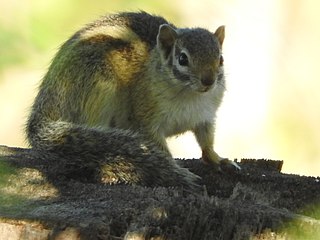
The olive-sided flycatcher is a small to medium sized passerine bird in the family Tyrannidae, the Tyrant flycatcher family. It is a migratory species that travels from South to North America to breed during the summer. It is a very agile flyer and mainly consumes flying insects on flight. Since 2016, this species has been assessed as being near-threatened globally (IUCN) and threatened in Canada (SRA) due to its declining populations.

The southern bog lemming is a small North American lemming. Its range overlaps with the other species in genus Synaptomys, the northern bog lemming, in southeastern Canada, but extends farther south.

Smith's bush squirrel, also known as the yellow-footed squirrel or tree squirrel, is an African bush squirrel which is native to woodlands of the southern Afrotropics.

The African bush squirrels are a genus of squirrels, Paraxerus, in the subfamily Xerinae. They are only found in Africa. The 11 species in this genus are:
Praslinia cooperi, or Cooper's black caecilian, is a species of caecilian in the family Grandisoniidae. It is monotypic in the genus Praslinia. It is found on Mahé and Silhouette Islands in the Seychelles. An old reported sighting on its namesake Praslin is not known to be correct.
Ptychadena cooperi is a species of frog in the family Ptychadenidae. It is endemic to Ethiopia.

Alexander's bush squirrel is a species of squirrel native to the Democratic Republic of the Congo and Uganda. It is arboreal and lives in tropical moist forests, especially undisturbed mature forests. It is a common species with a wide range, and the International Union for Conservation of Nature has rated it as being of "least concern". Its common name and Latin binomial commemorate Lieutenant Boyd Alexander, a British Army officer, explorer and ornithologist.
Boehm's bush squirrel is a species of rodent in the family Sciuridae found in Burundi, the Democratic Republic of the Congo, Kenya, Rwanda, South Sudan, Tanzania, Uganda, and Zambia. Its natural habitats are subtropical or tropical moist lowland forest, subtropical or tropical moist montane forest, and moist savanna.

The striped bush squirrel is a species of rodent in the family Sciuridae found in Kenya, Malawi, Mozambique, and Tanzania. Its natural habitats are moist savanna and plantations.

The black and red bush squirrel is a species of rodent in the family Sciuridae occurring in Malawi, Tanzania, and Zambia. In Malawi, it is found in Misuku Hills and Nyika Plateau and in Tanzania Poroto Mountains and Mount Rungwe; it has not been found in Zambia where it was expected to occur in Mafinga Hills and Makutu Mountains. Its natural habitats are subtropical or tropical moist montane forest, subtropical or tropical dry shrubland, and subtropical or tropical dry lowland grassland. It may be threatened by habitat loss.

The ochre bush squirrel is a species of rodent in the family Sciuridae found in Kenya, Somalia, and Tanzania. Its natural habitat is dry savanna.

The red bush squirrel or red-bellied coast squirrel is a species of rodent in the family Sciuridae, which is found in bush and forest along the eastern seaboard of Africa. It is closely related to P. lucifer, P. vexillarius and P. (p.) vincenti.

The green bush squirrel is a species of rodent in the family Sciuridae. It is found in Benin, Cameroon, the Republic of the Congo, the Democratic Republic of the Congo, Ivory Coast, Equatorial Guinea, Gabon, Ghana, Guinea, Liberia, Nigeria, and Sierra Leone.

Swynnerton's bush squirrel, also known as Svynnerton's bush squirrel, is a species of rodent in the family Sciuridae endemic to Tanzania. Its natural habitat is subtropical or tropical moist montane forests.
Vincent's bush squirrel is a species of rodent in the family Sciuridae, named in honour of Jack Vincent. It is endemic to Mozambique. Its natural habitat is subtropical or tropical moist montane forests, and it is threatened by habitat loss.
Faxonius cooperi, the Flint River crayfish, is a species of crayfish in the family Cambaridae. It is endemic to Alabama and Tennessee in the United States. The common name refers to the Flint River, where the original specimens were found.

Pseudanthias cooperi, the red-bar anthias is a Pseudanthias fish from the Indo-Pacific Ocean that occasionally makes its way into the aquarium trade. It grows to a size of 14 cm in length.














